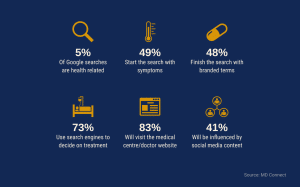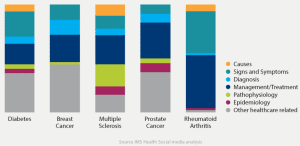There is a problem with statistics. On one hand, statistics are highly appealing, especially in a complex world like marketing and consumerism. On the other hand, the statistical picture can be significantly biased when examined in depth. This is precisely what may happen to marketers using medical content in the field of healthcare.
Dr. Google and Mister Hype: The World Shifts to Digital Medicine
What we experience as consumers of products also applies to us as healthcare consumers. For instance, we often arrive at the store or doctor’s office already equipped with a wealth of knowledge we acquired beforehand. Additionally, we prefer to make purchases or receive diagnoses from the comfort of our homes, where we have more control over the process. The knowledge revolution brought by the digital world is also changing the face of the medical field. And it’s not just doctors who are involved; one out of every 20 searches on Google is healthcare-related.
Here are a few intriguing numbers about our digital behavior in the medical realm: 49% of medical searches on Google in the United States start with symptom checking, and 48% end with searches for brand names within the medical field, such as medications, clinics, or doctors. 73% of Americans rely on Google searches to make decisions about their treatments, 83% won’t give up on visiting a doctor’s or clinic’s website before deciding where or with whom to go, and 41% are influenced by social media when choosing a treatment, provider, or medication.

Statistical data is extremely valuable for constructing a marketing funnel in the field of healthcare. According to the statistics, such a funnel would begin with awareness through symptom-focused content, continue with providing disease-related information or treatment options to audiences who are already in the upper stages of the funnel, and conclude with promoting action that encourages seeking diagnosis or obtaining specific medication information. This is precisely where the consumer journey of the target audience can be easily overlooked.
Diseases are not all alike: Understanding target audiences is crucial
Let’s start with common sense and move on to research. Common sense dictates that an individual suffering from a chronic illness and an individual suddenly experiencing symptoms of an acute medical condition would conduct different searches and expect different results on Google. Common sense also tells us that there are diseases with more varied treatment options and those with fewer options, diseases with a plethora of medications and alternative therapies, and those with virtually no options. Depending on the type of disease or medical condition, the consumer journey and content consumption will vary.
Here’s a glimpse into research that illustrates this precisely. The colors on the graph represent areas of interest searched by patients, and each column represents a different disease: diabetes, breast cancer, ovarian cancer, colitis, and common arthritis.

We can see, for example, that searching for the reasons for a disease is generally irrelevant for cancer patients but meaningful for arthritis patients. We can also observe that searching for symptoms, which statistics show comprise half of the searches, is more relevant for colitis and diabetes than for ovarian cancer.
In other words, the marketing funnel built for the treatment of colitis is not the same as the one built for breast cancer patients. Since an effective marketing funnel is developed only after understanding exactly what the target audience needs, a deeper understanding of the audience, their diseases, and the physiological and psychological processes they undergo is critical, far more than general statistics on medical Google searches.
What about doctors? B2B audiences also require in-depth analysis
Marketing in the healthcare industry is generally conducted through two channels: addressing patients and addressing physicians. Approaching physicians as a single entity may miss marketing goals. An orthopedic surgeon deals with a different patient population compared to a neurologist or a family physician. A physician in the early stages of their career may not be interested in the same topics as a highly experienced physician.
Here’s an example. In a research study we conducted for a major financial institution targeting physicians, we examined the types of articles that would interest them. One of the content types we explored was related to the challenges of establishing a private clinic. Again, relying solely on general statistics could be misleading, as there is significant variation among physicians in different specialties, as shown in the graph.
The reasons for this distribution are related, among other factors, to the question of how significant a specialty is in the private healthcare sector and how costly it is to establish a clinic in that field, considering the size of the clinic and the required basic equipment. The establishment of an ophthalmology clinic, for example, is significantly more expensive than establishing a family medicine clinic. Therefore, an ophthalmologist would be more interested in an economic guide for clinic establishment than a family physician.
Medical content – segmenting target audiences is of utmost importance
The key takeaway is that when planning a digital marketing strategy in the healthcare industry, it is crucial to thoroughly investigate the consumer journey, the marketing funnel, and the types of content that patients want to receive in each stage. As always, content is the patient’s best friend, and if we deliver exactly what they need, the likelihood of them staying with us throughout the journey is high.



